
France in a nutshell – the essentials in 15 minutes
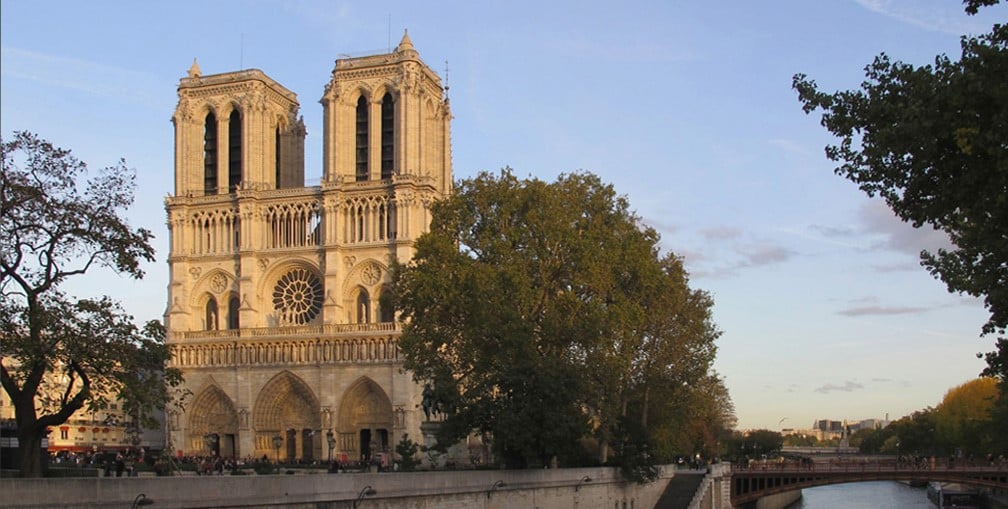
This post is also available in:
![]()
“France in a nutshell” is designed for tourists visiting France and Paris who want to know more than the usual clichés. It’s an overall description of France, not exhaustive but rich enough to give you a precise idea of the country and its people. It wasn’t an easy task to write, as France is average in many respects: in geographical size, in the economy, in the number of inhabitants. But it also includes an enormous number of variants and varieties that are difficult to dismiss, condense or over-generalize.
This article will take around 15 minutes to read, but you’ll have covered everything you need to know before or during a stay in France.
As the subject is vast, we haven’t dealt here with the History of France, which is the subject of a specific article entitled “History of France summarized for curious tourists”…
Physical geography of France in a nutshell
France is surrounded by water
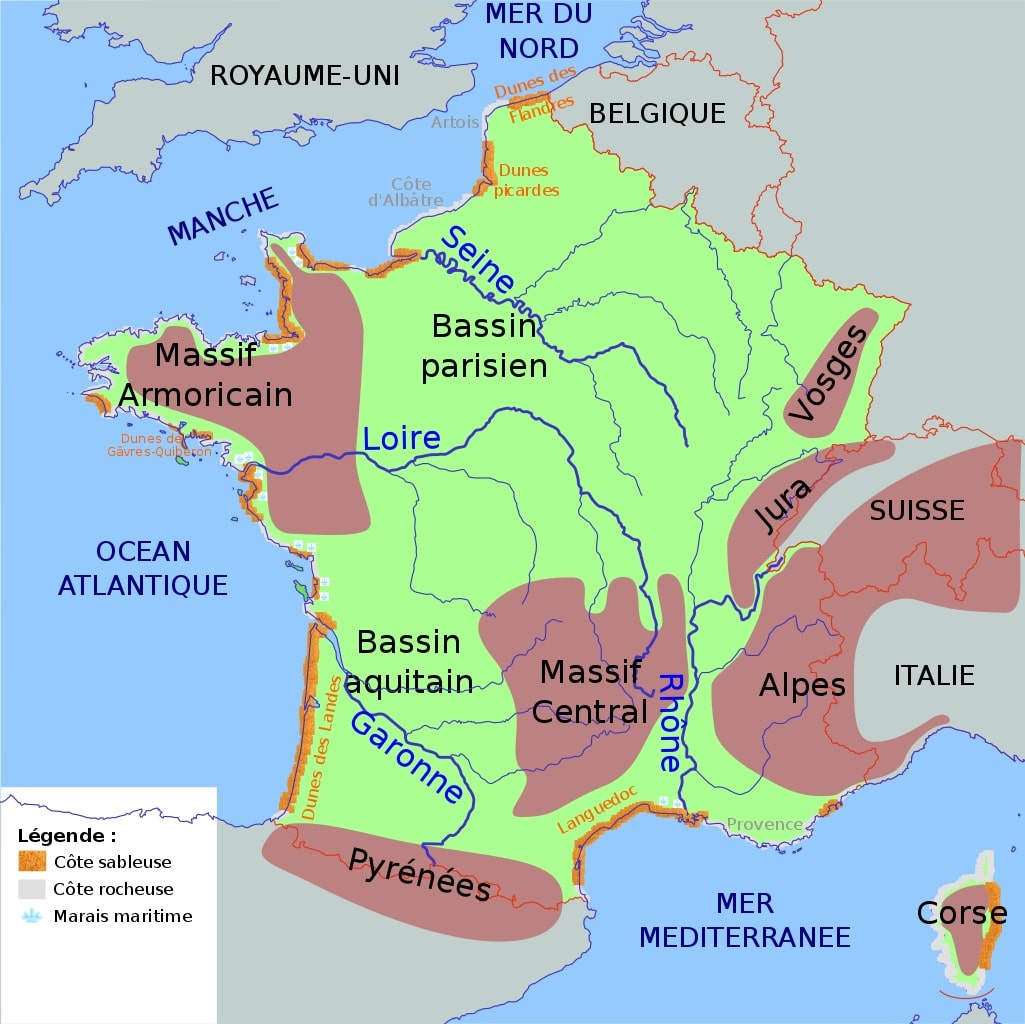
Metropolitan France is bordered by some 5,500 km of coastline, either Atlantic (approx. 4,100 km) or Mediterranean (1,694 km including Corsica 688 km), although France is only 1,000 km from north to south and 950 km from east to west.
The presence of the Mediterranean in the south-east of France, a virtually closed sea, is warmed by the high temperatures encountered on the African coast. It is a reservoir of heat whose influence is particularly felt on the Côte d’Azur and in the south-east of the country (as well as in Italy and Spain). → URL Climate
Relief: young and ancient mountains
The territory as a whole is characterized by the importance of plains and low plateaus (more than two-thirds of the territory is below 250 m). The mountains themselves are often bordered or penetrated by valleys, becoming routes for traffic and settlement. Latitude, proximity to the Atlantic and the lay of the land explain the predominantly oceanic climate.
Relief has a direct impact not only on its own (mountain) climate, but also on all the surrounding regions, such as plains and valleys. So it’s useful for a tourist visiting France to have a clear idea of which mountains he’ll have to cross, and which terrorists he’ll have to stay in.
- The Alps border Switzerland and Italy to the east. The Alps extend as far east as Liechtenstein, Austria, southern Germany and Slovenia. They are young mountains formed during the Mesozoic (-252 to -66 million years ago) and the Cenozoic (since -66 million years ago). The Alps culminate at 4,806 meters on Mont Blanc1. There are 82 major peaks over 4,000 meters in altitude (48 in Switzerland, 38 in Italy and 24 in France). Mountain passes linking valleys and countries often exceed 2,000 meters in altitude. The Alps form a 1,200-kilometer barrier between the Mediterranean Sea and the Danube.
- The Jura dates from the Quaternary era (-2 million to -20,000 years ago). Its highest point is 1720 m (Crêt de la Neige). It forms the boundary with part of Switzerland.
- The Vosges mountains to the northeast, with 14 peaks over 1,300 m in height (1,424 m at Grand Ballon, the highest point). The original Hercynian chain, formed 300 million years ago, consists of granite and volcanic rock. Heavily eroded during the Secondary Era, this ancient massif was uplifted during the Tertiary Era by the formation of the Alps, before collapsing at its center to form the Rhine Graben (which allowed the Rhine River to flow through). The Vosges mountains and the Black Forest in Germany appear as a result of the Rhine collapse. They are evidence of one of the gigantic active faults that fractured Europe sixty-five million years ago at the beginning of the Tertiary era.
- The Pyrenees range in the south between France and the Iberian Peninsula (Spain). 430 kilometers long, from the Mediterranean Sea (Cap de Creus) to the Bay of Biscay (Cap Higuer). It culminates at 3,404 meters altitude at the Aneto peak (Spain). The Pyrenees are a young mountain belonging to the Alpine belt – dating back some 40 million years, but beginning to form in the Campanian period (between 80 and 70 million years ago) – born of the collision of two terrestrial plates, the Spanish and the European.
- The Pyrenees are artificially divided into three parts: the Western Pyrenees, the Central Pyrenees and the Eastern Pyrenees. The central part is home to the highest peaks above 3,000 meters, such as Aneto (the highest peak in the Pyrenees at 3,404 meters) and Vignemale (the highest peak on the French side at 3,298 meters). There are few crossing points between France and Spain (Col de Puymorens);
- The Massif Central is the mountain range in central France. Less high because older and worn by erosion, it culminates at 1,885 meters at the volcanic summit of the Puy de Sancy (south-west Puy-de-Dôme). On the whole, the Massif Central is an ancient Hercynian massif composed mainly of granitic and metamorphic rocks. It was formed 500 million years ago, although the causses and especially the volcanic reliefs are more recent. In fact, when it was formed 250 to 300 million years ago, the Alps collided with the eastern flank of the Massif Central to raise it up (and the development of the Alps towards the Pyrenees 180 million years later – did the same in the south-eastern part. As a result, numerous volcanoes appeared in the northern part of the Massif Central, which became a volcano “field”. Today, there are 80 (extinct) volcanoes, i.e. most of the volcanoes in mainland France. This area is known as the “Chaîne des Puys”, a tourist and hiking region. Covering 35 km, it includes 80 volcanoes ranging in height from 50 m to 500 m, on a granite plateau at an altitude of 1,000 meters. This northernmost group is the youngest: 95,000 to 8,500 years old (7,000 if we include the Pavin).
- The Armorican Massif in Brittany is the Breton orogenic phase, dating from the beginning of the Lower Carboniferous, or Tournaisian, period around 360 million years ago. Erosion has meant that high points rarely reach an altitude of 400 meters.
- The Ardennes is a small, ancient and now eroded massif located between France, Luxembourg and Belgium. The oldest Ardennes orogenic phase ended Caledonian folding and began Hercynian folding (at the beginning of the Lower Devonian, or Gedinnian, around 400 million years ago). The highest points are between 500 and 600 m, with the highest point at 694 m at the “Signal de Botrange” in Belgium.
- The Morvan. It is the smallest mid-mountain area in the Bourgogne-Franche-Comté region, bordering the departments of Côte-d’Or, Nièvre, Saône-et-Loire and Yonne. It covers an area of just 5,000 km², at low altitude (400 to 901 m, with an average altitude of around 600 m). It is a remnant of the Hercynian Massif, like the Massif Central and the Massif Armoricain. It is a barrier between the Paris Basin and the Saône Valley, and thus the Rhône, which required costly road and rail (TGV) works to cross it.
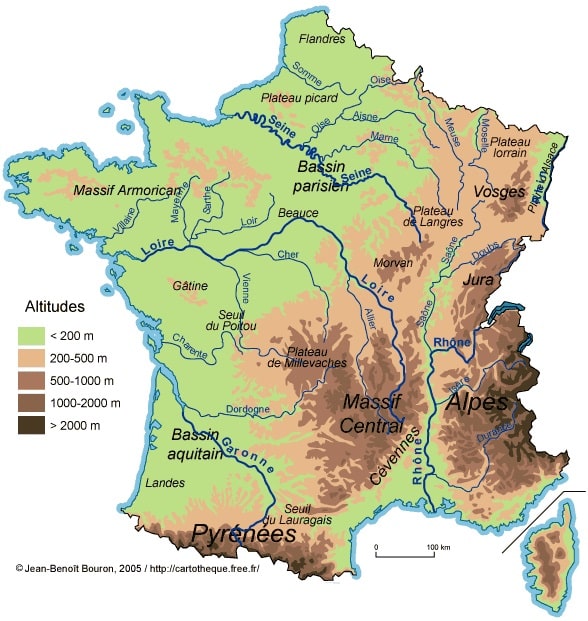
Rivers, valleys and a large central plain: where population and economy have developed
River basins
The formation of the mountains naturally led to the evacuation of rainfall as directly as possible towards the Atlantic Ocean and the Mediterranean Sea. Rivers flowed through the valleys between the mountains, defining their watersheds. This has helped to define France’s main means of communication, most of which run through the valleys.
In France, each mountain drains its water into its own river or rivers:
- The Rhône Valley and its river, the Rhône, whose source is in the Swiss Alps.
- The Garonne Valley and its river of the same name, with its source in the Pyrenees Mountains
- The Loire Valley and its river, which rises in the Massif Central
- The Seine Valley and its river originating in the Morvan region
- The Alsace Plain and its river, the Rhine. Its source is in the Swiss Alps, close to the source of the Rhône. It flows along Liechtenstein, then Austria, returns to Switzerland, serves as the border between France and Germany, and then enters the Netherlands, where it flows into the North Sea, mixing with the Meuse river, whose source is in the Vosges, close to the Saône river, a tributary of the Rhône.
The valleys have created specific climatic conditions: mild temperatures as in the Loire Valley (Angevin climate) or the Mistral wind that “descends” from the north in the Rhône Valley, or a continental climate in the Rhine Valley (cold in winter, hot in summer).
The central plain of France in a nutshell
The great plain, almost the center of France, slopes down from Belgium in the north to the Pyrenees chain at the Spanish border in the south. It includes the Paris region (City of Paris) and the Aquitaine region (Bordeaux). This plain is swept by the prevailing westerly winds from the Atlantic, which are mild but often wet. But for certain positions of the Azores anticyclone, this leaves the door wide open to winds from northern Europe or from Russia and Siberia. Which is less pleasant in winter. URL → Climate
Water management
The water problem is becoming increasingly serious. In some regions, the water table has virtually disappeared, at least for part of the year. For many years now, the organization of water management has been taken into account in the management of French territories.
Integrated water management is carried out on a watershed basis in relation to each of the main rivers, involving all water stakeholders in a process that promotes the coordinated development and management of water, soil and associated resources. The aim is to maximize economic and social benefits, in an equitable manner, without compromising the sustainability of vital ecosystems → map
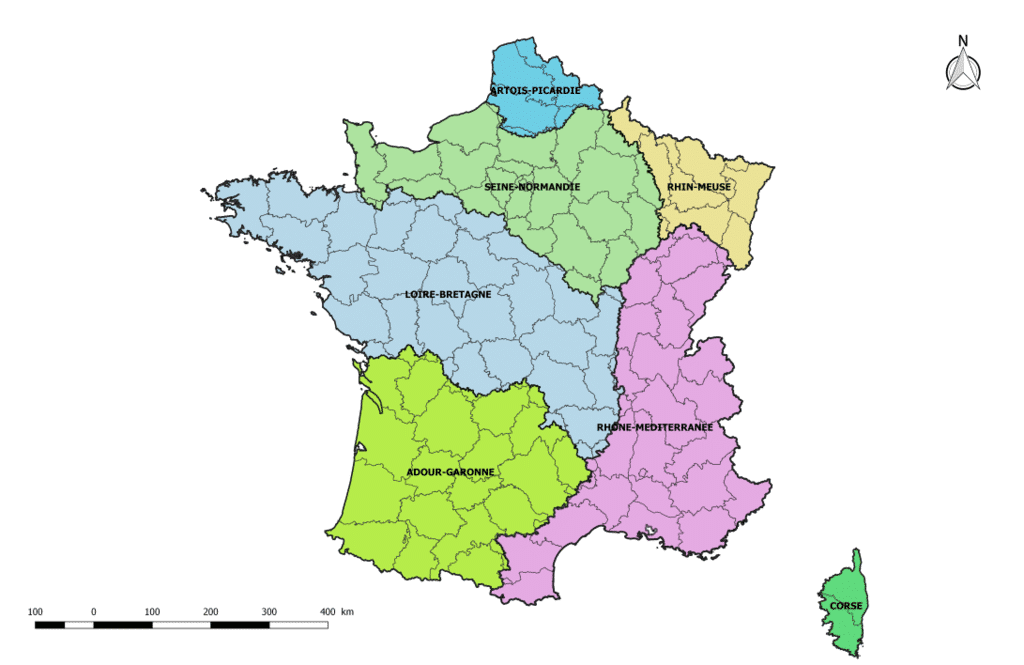
The settlement of France
Origin and evolution of the peoples of France
For more details, see our “History of France in a nutshell”.
The original France was called “La Gaule” by the Romans in the last centuries BC and early AD.
If 15,000 years BC the population was 50,000 for the whole of Gaul, they were only 6,000,000 at the start of the Roman conquest, rising to 21,000,000 in 1700 (the most populous country in Europe) and 41,630,000 in 1914 (on the eve of WW1) but dropping to 38,770,000 in 1944 (at the end of WW2). On January 1, 2022, the population was 67.8 million.
Population distribution in metropolitan France – France’s major cities
Today, 75% of the population is concentrated in 20% of the territory, and the average density is 106 inhabitants per km², much lower than in other European countries, with the exception of Spain. In the Netherlands, the average density is 461 inhabitants/km².
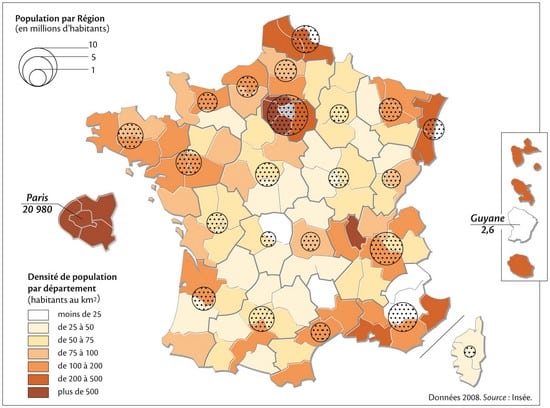
The Île-de-France region, around Paris, dominates in terms of population density, with 20% of the population living on 2% of the territory. There is a marked imbalance between Paris and its 10 million inhabitants (including the nearby and distant suburbs) and the rest of the country.
Other densely populated regions are those with large valleys, seasides, border areas, northern and southeastern regions, i.e., regions with large cities: population density and urbanization are linked. From the north-east to the south-west, densities are much lower, particularly in the Massif Central and above all in Limousin, which is also the least populated of the French regions and the one with the oldest population. Overall, France is an underpopulated country compared to its neighbors.
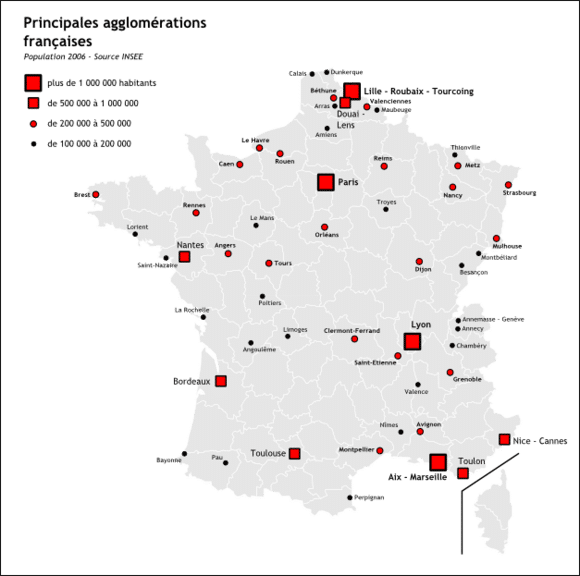
Settlement and evolution of France
As a result of its long history of settlement, the French countryside is highly “humanized”, and has undergone more or less continuous transformation over the centuries. This historical perspective should not be lost sight of, even if the pace of change accelerated with the industrial revolution, and even more so since the end of the Second World War.
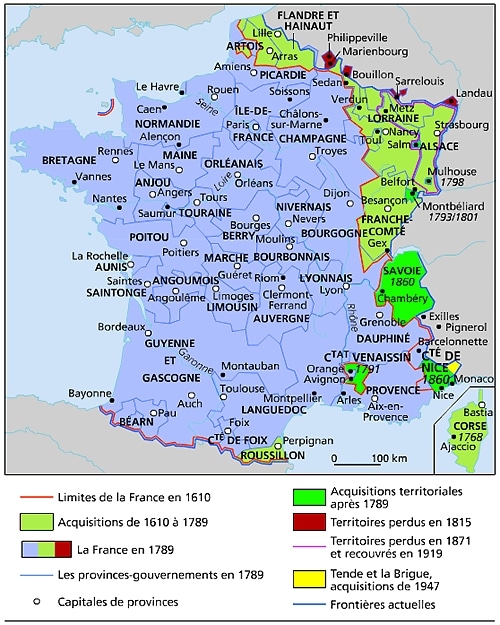
Continuity is clearly evident in a number of areas: the overwhelming weight (political, economic, demographic) of Paris and, henceforth, its region (Île-de-France); “de-ruralisation” and, correlatively, urbanization, which affects 80% of the population; the persistence of certain population contrasts (low density in mountainous areas, attraction of middle and lower river valleys).
France remains by far the European Union’s leading agricultural power. Today, it exports around 20% of its total production (mainly to its European Union partners), selling mainly industrial products (automobiles, aircraft, etc.) as well as agricultural surpluses. Purchases of mineral and energy raw materials (oil in particular) weigh heavily on the balance of trade, which is now largely in deficit. The balance of payments situation is improved by the surplus on tourism, but the country is heavily indebted.
Awareness of the imbalance between Paris and the French provinces goes back a long way, and the French government, by implementing a regional planning policy, has endeavored to respond to this challenge, sometimes successfully, notably through subsidies and tax incentives. But the role of public authorities appears ambiguous. In the essential field of transport, for example, the old Paris hub-and-spoke pattern was continued for freeways and then for TGV trains.
Ruptures are often the consequence of upheavals in the French economy: the disappearance of mining activities, which has devastated entire regions (Nord-Pas-de-Calais, Lorraine); the transformation of industrial sites, with the abandonment of the giant factory model and the emergence of technology parks; the rise of tourism, which has favored the development of coastal and mountain areas that had previously been neglected…
French demographics in a nutshell
Population figures
- Population: 67,749,632 (2021)
- Density: 122 inh./km2
- Urban population share (2022): 81%
- Population structure by age (2022) :
- under 15: 17%
- 15-65 years: 62%
- over 65: 21%
- Birth rate (2022): 11 ‰
- Mortality rate (2022): 10 ‰
- Infant mortality rate (2022) : 3 ‰
- Life expectancy
- men : 79 years
- women : 86 years
The population: characteristics
France’s population represents barely 1% of the world’s population. The natural surplus, on the order of 200,000 people per year, is the strongest in Europe, as the birth rate (11 ‰) has remained higher than the death rate (10 ‰) and the population is growing at a reduced rate (around 0.1% per year). The fertility rate is declining significantly and stabilizing…
The natural surplus, of around 200,000 people per year, is the strongest in Europe, as the birth rate (11 ‰) has remained higher than the death rate (10 ‰) and the population is growing at a reduced rate (around 0.1% per year).
The fertility rate is falling significantly, stabilizing at 1.8 children per woman, a figure higher than the European average (1.5).
The population is aging: only 17% are under 15, while the proportion of people aged 65 and over is 21%. Female life expectancy at birth is one of the highest in the world (86 years).
Immigrants, notably from Portugal and Algeria, account for around 6% of the total population, but locally (in large conurbations) they can account for 10-15%.
More than three-quarters of the French population live in cities. With over 12 million inhabitants (2 million within the city limits), the Paris conurbation is home to one-sixth of France’s population (far ahead of Lyon and Marseille, the only other two cities with over a million inhabitants).
The urban network is also characterized by a close-knit network of regional capitals (200,000 to 700,000 inhabitants, dominated by Toulouse, Nice, Nantes, Strasbourg, Montpellier, Bordeaux and Lille) and medium-sized towns (20,000 to 200,000 inhabitants). Average population density (121 inhabitants per km2 ) is well below that of other industrialized countries in Western Europe, particularly along a north-east-south-west diagonal through the Massif Central.
Transport and communications within France
Means of transport
Air traffic
The airport hubs have been modernized and expanded (Charles de Gaulle – Roissy). This airport now ranks 5th in the world’s top 100 airports. It can handle up to 80 million passengers. In terms of air traffic, i.e. take-offs and landings, it ranks first in Europe and tenth worldwide. Paris-Charles-de-Gaulle, with 57.5 million passengers, is behind Heathrow (61.6 million). But Paris-CDG is also Europe’s leading hub for intercontinental connectivity, and the third European hub for overall connections, behind Frankfurt and Amsterdam. It serves over 329 cities worldwide, with a minimum of 12,000 movements per year.
In terms of air freight, it ranks second in Europe and ninth worldwide.
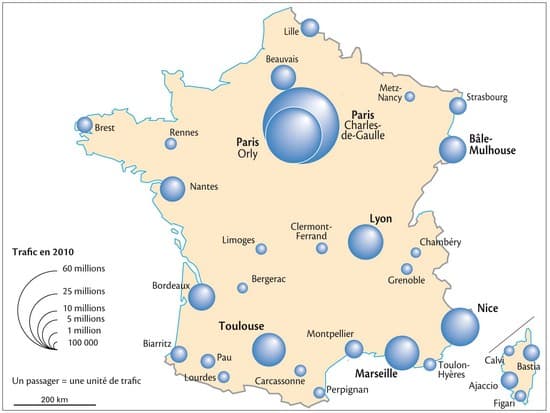
Road and motorway network
The road network of national, departmental and local roads is dense. It was supplemented by a network of freeways that initially linked Paris to the provinces, but in recent years, cross-country links have become available. These are difficult to build because of the general orientation of the rivers (see map…) and the presence of the Massif Central, a barrier to the south of the Loire River, between western and eastern France.
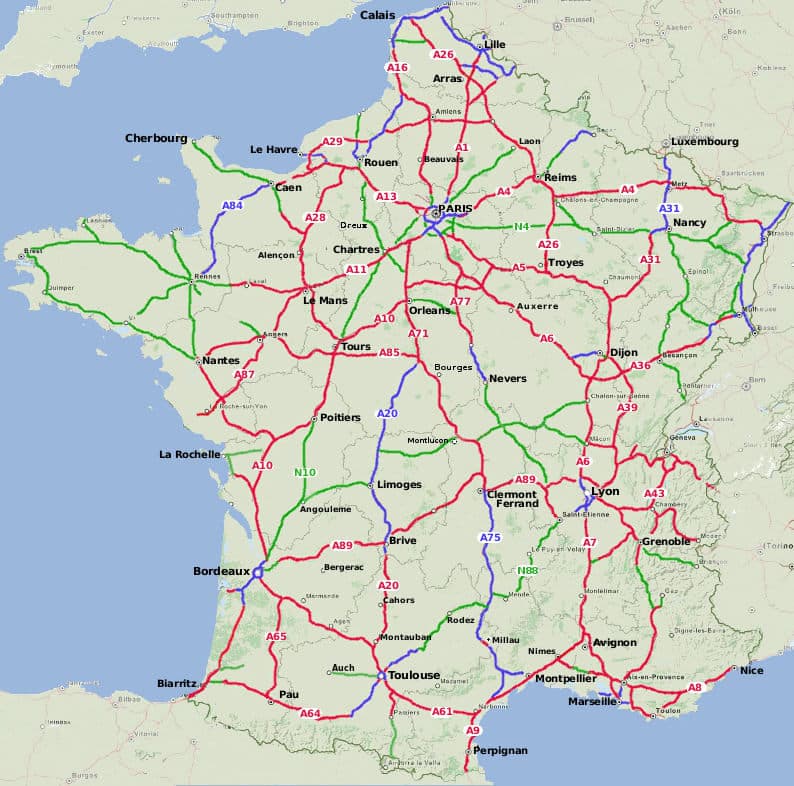
The rail network
The rail network comprises 28,000 km of track, including 2,700 km of high-speed lines.
Indeed, the most spectacular event has undoubtedly been the construction of TGV lines and the Channel Tunnel. This has enabled S.N.C.F. (the nationalized national railroad company) to recover some of the passenger traffic it had lost to domestic air travel. As far as overland freight is concerned, road continues to accentuate its pre-eminence, carrying more than rail and waterways alone, the latter being on the decline (river traffic has halved since 1970).
In France, the national rail network (RFN) is made up of railroad lines and infrastructure owned by the French state and assigned to SNCF Réseau.
In 2020, it will become the property of the State, while remaining entrusted to SNCF Réseau.
In 2018, with over 28,000 km of track in operation and more than 2,800 stops and stations served, France has the second largest network in Europe (behind Germany), as well as the leading network of high-speed lines.
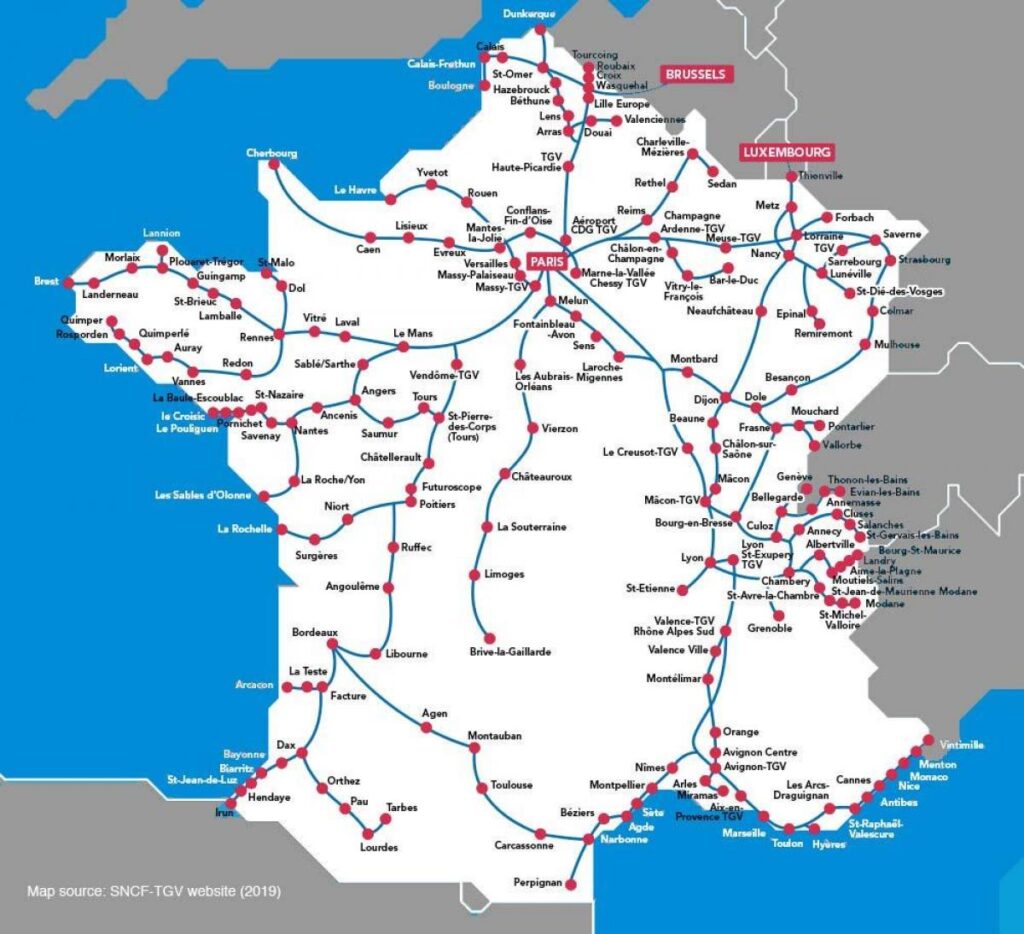
Waterways
The network of navigable waterways comprises all the rivers and canals that have been developed, equipped and opened to river traffic and transport.
It can transport very large tonnages, with low levels of pollution. Its disadvantages, apart from the slowness of routing in certain cases, lie in the weakness of the very unevenly distributed network of waterways and the need, with a few exceptions, for road terminal transport.
In 2017, the total length of the world’s inland waterways was estimated at 2,293,412 km, led by China (126,300 km in 2014) and Russia (102,000 km in 2009). The European network is around 38,000 km long, led by France (8,501 km in 2008) and Finland (around 8,000 km in 2013).
River freight transport
Large-gauge shipping lanes have been developed on several major rivers: Seine, Rhine and Grand Canal d’Alsace, Dunkerque-Escaut Canal, Moselle, Rhône.
River tourism
River tourism has developed on certain rivers and canals. It is highly diversified in terms of destinations, atmospheres and tourist products – from a few hours for pleasure boats to several days for cruises. In the case of cruises on rented personal boats, the change of scenery is total and the tourism exceptional. River tourism fits in perfectly with the aspirations of “slow tourism”, and is naturally associated with cycle tourism, walking and horse-riding, with over 80% of the river network now bordered by a cycle route. These “family” boat rental opportunities can be found in particular on
- The canals of Centre of France and Burgundy
- Canal du Midi and Canal du Rhône à Sète
- The Canal de la Marne au Rhin
- The Seine, a monument to river tourism (Click on Cruise-on-the-Seine in Paris, choose services, embarkation port and price)
- The Canal de la Sambre à l’Oise, a multicultural itinerary
- The Lys valley and the cross-border Lys (from Lille in France to Ghent in Belgium)
- The Garonne and the Canal Latéral à la Garonne
River tourism also exists through river liners and barge-hotels River liners and barge-hotels, an activity in which France is the world leader, make a major contribution to the industry’s dynamism and appeal to foreign customers (88% of cruise passengers), with significant growth potential on the Seine and Rhône rivers (35 liners in operation, compared with 136 on the Rhine). These cruises promote rural areas and the French art of living (gastronomy, oenology, etc.).
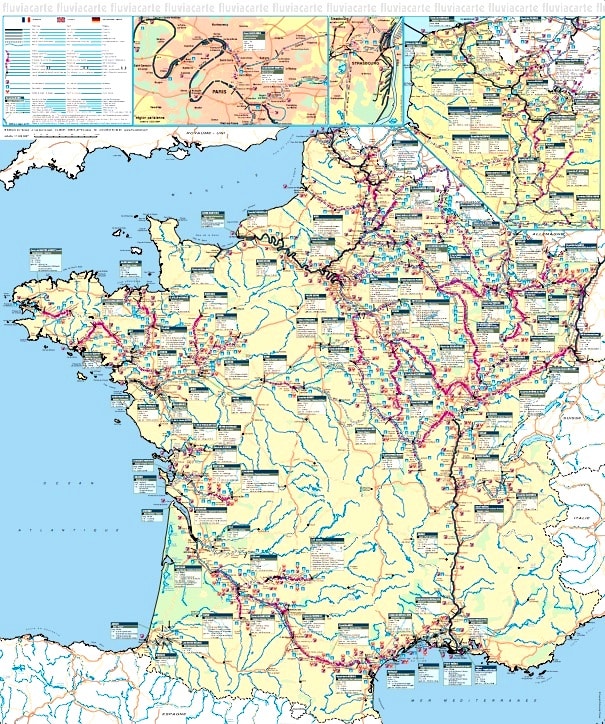
Organization of the French state in a nutshell
The administrative division of France
France’s territorial organization is a division of the national territory into hierarchical administrative subdivisions. Since the decentralization laws of 1982, it has been based on a balance between local authorities, administered by elected councils and endowed with genuine management autonomy, and non-elected decentralized State services, responsible for guaranteeing the unity of the Republic and the principle of equality before the law.
There are three levels of local government:
- communes (Towns), 34,816 in mainland France
- départements (made up of cantons) – 96 in mainland France, including 2 in Corsica, and 101 with the 5 overseas départements. – The départements are made up of 4,649 cantons within the current boundaries of metropolitan France. But large and/or densely populated departments can be administratively divided into “sub-departments” called arrondissements (2 or 7 per department). For 101 départements, there are 300 arrondissements.
- regions, or collectivités territoriales de droit commun – 12 in number, plus 1 in Corsica.
The central government is represented at regional level by a Préfet de région, at departmental level by a Préfet de département and in the arrondissements (parts of departments divided into 2 or 3 for the largest departments) by a Sous-Préfet.
The four levels of administrative districts under common law are as follows:
| Label | Administrative authority | Services |
|---|---|---|
| Région | Préfet de région | SGAR – Directions régionales – préfecture de région |
| Département | Préfet départemental | Directions départementales – préfecture départementale |
| Arrondissement | Sous-préfet | Sous-préfectures |
| Commune | Maire | Mairie |
French representations around the world
France is represented around the world through its diplomatic missions. With 163 embassies, France has the third-largest network of embassies and consulates in the world, after the United States (168 bilateral embassies) and China (164 embassies)38 . It is ahead of the United Kingdom (148) and Germany (145).
In 2019, the diplomatic and consular network includes 160 embassies, two French cooperation offices (Pyongyang and Taipei), 89 consulates general or consulates, 112 consular sections. Between 1989 and 2014, 62 embassies or consulates were closed and 48 opened.
France’s national political organization – The 5th Republic in a nutshell
The President of the Republic is in charge of executive power, assisted by a Prime Minister whom he chooses and who proposes a government (around 30 ministers). The government must be ratified by the “legislative chambers”.
Legislative power is entrusted to 2 chambers: the Chamber of Deputies (1st chamber, which sits in the Palais Bourbon, on the banks of the Seine, on the other side of the Place de la Concorde) and the Senate (2nd chamber, which sits in the Palais du Luxembourg).
Voting laws
Laws are initiated by the government, deputies or senators, or political groups represented in the assemblies. A law is first discussed (compromised) in specialized “commissions” (Foreign Affairs, Economy, etc.) in one of the chambers, then presented to the Deputies or Senators, who amend it and vote on it. It then passes to the other chamber for voting. In any case, it is the version passed by the National Assembly (the Deputies) that prevails over the Senate version.
Government responsibility
The government can be “resigned” if the Prime Minister is “thanked” by the President of the Republic or resigns of his own accord. But it can also be outvoted by the Chamber of Deputies. In any case, the government as a whole “resigns” at the same time as the Prime Minister. The President of the Republic must then form a new government.
A particular feature of the 5th Republic is the power of the government (i.e. the President of the Republic) to promulgate a law before it has actually been passed by Parliament. This is known as “Article 49-3”, and when it is used, it always causes a stir.
When the government wants to pass a law knowing that the majority in the assemblies means that it will not be voted, it presents the law to the National Assembly of deputies, “listens” to the criticisms and amendments proposed by the deputies, but does not ask them for a final vote. Needless to say, under these conditions, the number of amendments is several thousand, and the speaking time for each MP wishing to speak is 3 to 4 minutes. In return, parliamentary groups can propose a vote of no confidence to bring down the government – which never obtains a sufficient majority to be accepted.
This “article 49-alinea 3” was added to the constitution of the 5th Republic in 1958 to prevent the assemblies from being blocked for months on end, as happened quite regularly under the 4th Republic. At the time, the parties were so powerful in relation to the Executive that they parasiticized political life by “arranging” among themselves to place their supporters in ministerial posts in turn, bringing down successive governments. In twelve years, 22 governments succeeded one another, so that the average lifespan of Fourth Republic governments was seven months. Over the same period, ministerial crises lasted 375 days! The shortest government lasted 16 days, and the longest 16 months!
Presidents of the French Republic
The President of the Republic is in charge of executive power, assisted by the Prime Minister whom he chooses and who presents him with the members of his future government. In fact, the choice of ministers is more a matter for the Presidency than for the Prime Minister. He is also Chief of the Armed Forces.
Twenty-five people have held the office of President of the French Republic since 1848. Of the twenty-four whose term(s) ended before 2018, fourteen died or resigned during their term. This is particularly true of ten of the fourteen presidents of the Third Republic (September 1870 to July 1940).
The 1st President of the Republic was Louis-Napoléon Bonaparte, elected on December 20, 1848 and who, 4 years after his election, became Emperor Napoléon III. The last President, in office until 2027, is President Macron.
Since the constitutional revision of November 6, 1962, the President has been elected by direct universal suffrage in a two-round first-past-the-post system. The first presidential election by direct universal suffrage was held in 1965.
The President is elected in the first round if a candidate obtains an absolute majority of the votes cast. This has never happened under the 5th Republic.
If no candidate achieves the necessary majority in the 1st round, the two candidates with the highest number of votes are entitled to stand in a second round. The candidate who obtains the majority of votes cast in the second round is elected President of the Republic.
He is elected for a 5-year term, and may be re-elected only once consecutively.
He does not have the right to attend parliamentary assemblies (Chamber of Deputies or Senate), but he does have the right to send a message: he can communicate with messages that he has read from the rostrum. However, he can address Parliament (the 2 chambers sit together, in the same room) meeting in Congress (article 18). The Congress always meets in a dedicated room at the Château de Versailles, which is rarely used.
France’s electoral system
In France, election day is always on a Sunday, unlike in other countries where it is on a Tuesday.
Presidential election
Since the constitutional revision of July 23, 2008, presidential elections are held at the end of each 5-year term (except in the event of death or resignation). The next election will be held in May 2027. This is a 2-ballot election, with 15-day intervals between ballots.
European elections
This is a single national constituency (France is a single constituency) based on a list of candidates standing for election to the European Parliament. It is a single-round election, held every 5 years. The next election is scheduled for June 9, 2024.
- Legislative elections
This is the election of French deputies to the 1st Chamber of Parliament, which sits at the Palais Bourbon (opposite the Place de la Concorde, on the other side of the bridge of the same name). The number of deputies is 577, corresponding to 577 legislative constituencies (539 in mainland France, 19 in overseas departments, 8 in overseas collectivities and 11 for French citizens living abroad). Elections are held in 2 rounds (2 consecutive Sundays) for a 5-year term. The next election will be held in spring 2027.
- Senate elections
The Senate comprises 348 French senators, elected by indirect universal suffrage, by a college of “grand electors”. Half the Senate’s members are re-elected every three years, so the term of office is six years. The basic electoral constituency is the département. The College of Electors is made up of deputies and local elected representatives. The last election took place on September 24, 2023.
- Regional elections
The law of April 11, 2003 created regional lists with departmental sections. Each list comprises as many sections as there are departments in the region (generally around ten, depending on the region’s size and population). Regional representatives are elected for 6 years, with the next election scheduled for March 2028.
- Departmental elections (Cantons)
The new system is a binomial election (one man and one woman) with two rounds of voting. Elections are held at the same time as regional elections. They are elected for 6 years, and the next election will be held in March 2028.
- Municipal elections (Communes)
France has 3,4968 communes (i.e., communes headed by a mayor). Some communes have just 2 to 300 inhabitants, while Paris has 2 million. Elections are held in 2 rounds (2 Sundays, one week apart), on lists of candidates from which the municipal councillors assist the Mayor, chosen at the 1st meeting of the Communal Council. Elections are held every 6 years, with the next scheduled for March 2026.
France’s legal system
The legal system is organized into two main families called orders:
- the administrative order, which deals with disputes between the State and individuals,
- and the judicial order, which comprises 2 “sub-sections
- civil justice, which settles disputes between individuals.
- and criminal justice. The criminal courts judge individuals or corporate bodies suspected of having committed an offence (contravention, délit or crime). Depending on the seriousness of the offence, the jurisdiction (or court) will vary. Prison sentences or fines may be imposed.
French courts and jurisdictions
French justice comprises several types of courts or jurisdictions that “follow” the organization of the legal system
Civil Courts
The court of jurisdiction depends on the type of dispute and the amounts involved.
- The Courts of First Instance are the courts which first judge disputes between private individuals (neighbor disputes, divorce, dismissal, etc.). These courts do not pronounce penal sanctions, but they can order one of the parties in dispute to pay a sum of money. At any stage of the proceedings, the civil court may also require the parties to meet with a mediator appointed by the court.
- Courts of appeal (Cour d’Appel and Cour de Cassation) When you are not satisfied with a first-instance judgment, you can appeal. The Court of Appeal then re-examines the case and issues a new decision.
If you are not satisfied with the appeal decision, you can “appeal to the Court of Cassation”. The Court of Cassation does not re-examine the case, but checks whether the trial and appeal judges have correctly applied the law.
Criminal Courts
Criminal courts judge individuals and corporate bodies suspected of having committed an act prohibited by law. The act in question is an offence. Note that courts of first instance hand down judgments, and courts of appeal hand down rulings.
- Courts of 1st instance in criminal matters according to the importance of the fault
There are 4 criminal courts:- the police court for minor offences (this court mainly imposes fines),
- the tribunal correctionnel (criminal court) for misdemeanors (this court judges misdemeanors committed by adults – theft, serious violence, etc. – and contraventions related to the misdemeanors for which they were issued),
- the departmental criminal court (The departmental criminal court is the first instance court for adults accused of a crime punishable by 15 to 20 years’ imprisonment (rape, armed robbery, etc.), except in cases of recidivism).
- the assize court for felonies (The assize court judges felonies (murder, rape, armed robbery, etc.), i.e. offenses punishable by over 20 years’ imprisonment up to life imprisonment. Since January 1, 2023, the Assize Court has also been responsible for the most serious offenses punishable by a prison sentence (voluntary manslaughter or rape, for example).
- Courts of 2nd instance: the 36 Courts of Appeal
These courts hear appeals against first-instance rulings. In other words, they re-examine cases that have already been judged by a court of first instance. The Court of Appeal is divided into several chambers:- the Correctional Appeals Chamber examines appeals against judgments handed down by the Correctional Court, the Sentence Enforcement Court and the Police Court,
- the Investigation Division hears appeals against orders by the investigating judge and the liberty and custody judge,
- the “civil” divisions hear appeals against rulings by the magistrates’ court and the local court,
- the Social Division examines appeals against rulings by the industrial tribunal, the social division
- and the joint rural lease tribunal,
- the Commercial Division hears appeals against rulings by the Commercial Court.
- Exception: an appeal against a 1st instance Assize Court judgment is heard by another Assize Court, not by one of the chambers of the Court of Appeal.
- Lastly, appeals may be lodged against decisions of the Court of Appeal. The Court of Cassation verifies that the law has been correctly applied, and therefore only on questions of law. The Court of Cassation can overturn the decision of the Court of Appeal and, if necessary, refer the case to another Court of Appeal.
Administrative courts
There are 42 administrative courts throughout France. Each administrative court comprises 1 to 18 chambers, depending on the size of the region.
The administrative courts judge disputes between individuals and government bodies (the State, local authorities, public establishments or private bodies with a public service mission) or between government bodies (the State against a local authority, for example).
- Administrative court of 1st instance Judges disputes in various fields: taxes, administrative contracts, public liberties, town planning, social law, etc.
- Administrative court of appeal possible except for decisions handed down by a single judge and/or claims for damages of less than 10,000 euros. In such cases, an appeal may be lodged with the Conseil d’Etat. This allows you to challenge a court decision which one of the parties considers to be contrary to the law or to have suffered a procedural defect.
European justice applied in France
This is ensured by the Court of Justice of the European Union (CJEU) and the European Court of Human Rights (ECHR).
- The Court of Justice of the European Union (formerly known as the CJEU) is part of the 27-member European Union. Based in the Duchy of Luxembourg, it is made up of 27 judges, one from each member state. Union law is based on two principles:
- direct effect, which enables an individual to invoke a Union law standard before national courts,
- the principle of primacy, which requires national courts to give precedence to Union law over national law.
- European directives must be transposed into national law.
- In particular, European Union law has led to advances in consumer rights, gender equality, non-discrimination and equal treatment, and social rights.
- The European Court of Human Rights (ECHR) is part of the Council of Europe, which has 46 member states. It is based in Strasbourg, France. It is the judicial authority of the European Union and, in collaboration with the courts of the member states, ensures the uniform application and interpretation of Union law. The European Court of Human Rights rules on infringements of the fundamental rights and freedoms protected by the Convention by the States parties.
France in the organization of Europe
France in terms of population in Europe
With just over 67 million inhabitants on January 1, 2021, France ranks second in the European Union in terms of population, behind Germany (82 million) and ahead of the UK (65 million), Italy (59 million) and Spain (47 million). France’s demographic weight therefore has an impact on its representation within European institutions.
The population of the European Union is 448.4 million, ahead of the United States (332 million) and Russia (143 million).
France alone ranks 21st among the world’s most populous countries.
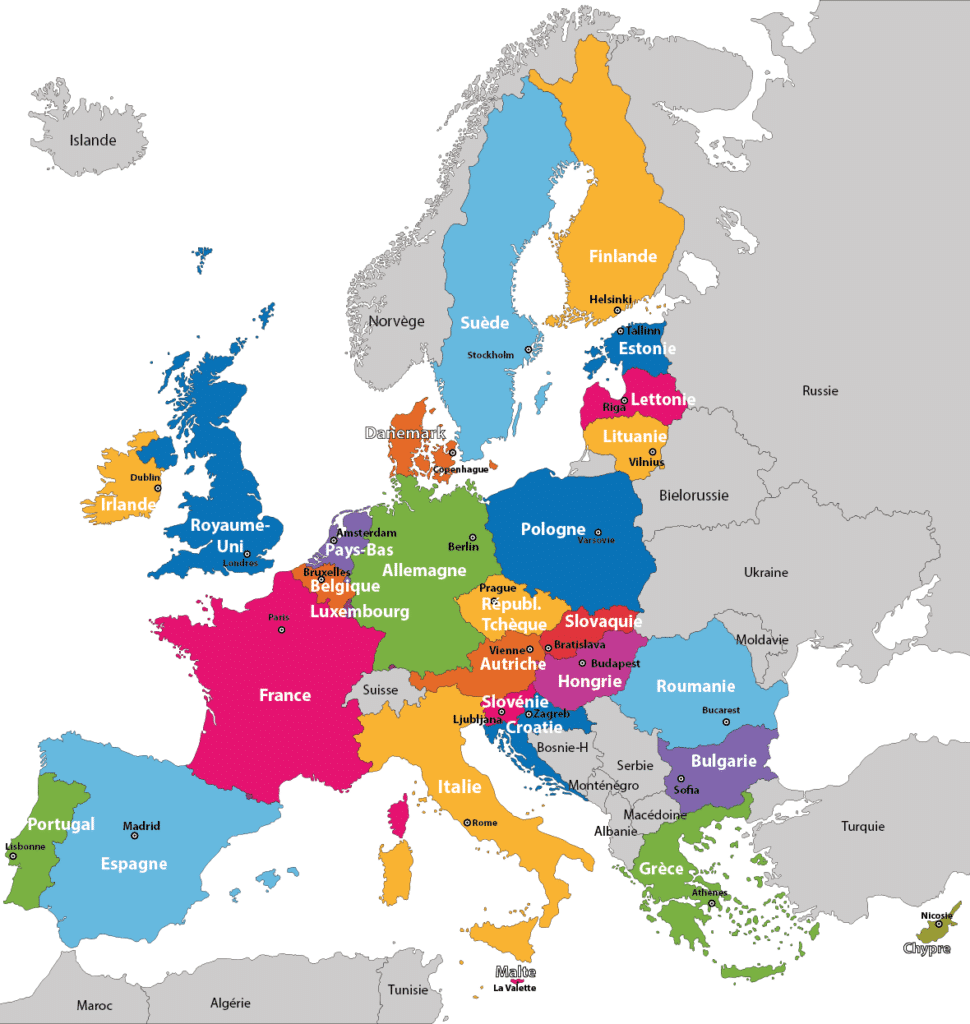
France on the European continent
France’s central position in Europe means that it has always been a transit point between the north and south of the continent. France is linked to its European neighbors by an extensive air, road and rail transport network.
France has the largest territory and most dynamic demography in the EU. Its economy, in second place (behind Germany and ahead of the UK), is characterized by a more developed tertiary sector, more concentrated industry and a more fragmented agricultural sector than those of its neighbors.
With a surface area of over 550,000 km² in metropolitan France alone, plus the 120,000 km² of the French overseas departments and territories, France is the largest country in the EU.
With three coastlines and land borders with eight European countries (including Andorra and Monaco), France occupies a central geographical position in Western Europe, at the crossroads of human and commercial exchanges. This position has frequently made it a battleground in the many conflicts that have traversed Europe over the centuries, contributing to its commitment to European unity.
France’s economic dynamism in Europe
Tourism generates over 7% of GDP. Thanks to its cultural and historical heritage as well as its natural sites, France is in fact the country that welcomes the most tourists in the world, with almost 90 million visitors in 2017.
With 2.2% of its GDP devoted to research and development, France is above the European average of 2%, but behind the Scandinavian countries, Germany, Austria and Belgium. In terms of patent registrations, however, it ranks second behind Germany (Insee data).
French-style centralism – unique in Europe
This is one of the legacies of France’s kings and of the country’s geography.
French centralism has also led to a concentration of industry around large groups (74 companies generating half of all industrial sales), with a focus on international development through foreign investment.
Agriculture and fishing in Europe as a whole
Agriculture and fishing employ just 2.7% of the French workforce and account for just 1.6% of GDP, but thanks to its size and favorable climate, France is the leading agricultural producer in the EU and seventh worldwide. Within the EU, it is the leading producer of cereals (making it the “granary” of Western Europe) and beef, the second largest producer of wine (behind Italy) and milk (behind Germany).
France has the second-largest maritime domain (the “exclusive economic zone”) in the world, after the United States, and the largest fishing fleet in Europe, but with 25% of its fish caught in international waters or in the waters of third countries under fishing agreements, France has lower catch rates than Spain, Denmark and the United Kingdom.
France’s driving role in the construction of Europe – In a nutshell
Given its geographical, demographic and economic position in Europe, France has played a decisive role at every stage in the construction of today’s Europe. The architecture of European structures, from the ECSC to the EEC and EU, largely reflects a French vision of Europe, spelled out as early as 1950 in France’s Schuman Declaration, which provided the decisive impetus for today’s European project.